Thermochemical Mantle Plumes as the Source of the Earth‘s Ore Resources
The Earth’s crust stores enormous resources of nonferrous and noble metals. What is their origin? Geologists from Novosibirsk, Russia, have developed the concept of a thermochemical plume. It is a hoist that delivers the precious cargo from the core to the surface of the Earth. On the basis of experimental data and modeling a concept of ore deposit formation has been constructed which is likely to facilitate ore prospecting and mining
The second half of the 20th century witnessed several revolutions in the understanding of the causes of the global geologic processes that govern the evolution of the Earth’s spheres. First, the plate tectonics theory appeared, which produced models of spreading zones, where the oceanic crust emerges, and subduction zones, where the crust submerges into the mantle and a new continental crust is generated. Fundamentals of this theory are now given in schoolbooks. Second, the theory of mantle plumes was elaborated: the rise of heat and matter from the deep layers of the Earth in the form of local jets.
Mantle plumes are thought to be independent of plate tectonics. An example is the Hawaiian–Emperor seamount chain. It is a track on the Pacific tectonic plate, resulting from the movement of the latter over a plume, the Hawaii hotspot. However, it is indicated in the monograph by Dr. V. E. Khain (2003) that there were epochs in the Earth’s history when plate tectonics was predominant, whereas other epochs were dominated by plume tectonics.
At present, a new geological concept is being developed: deep-level geodynamics. It considers the nature of global processes with regard to the interaction of the Earth’s spheres in a wide depth range, to the very core (Dobretsov, 2001). This approach is based on seismic tomography, which allows detection of mantle discontinuities on the basis of differences in the velocities of seismic waves passing through different media (Zhao, 2010; Kulakov et al., 2011). Due to the progress in experimental high- and ultrahigh-pressure petrology, the phase composition of the lower mantle and the core–mantle boundary (CMB) was substantiated. It was shown that in the epochs of intense plume activity oceanic plates could submerge down to the CMB to form a low-viscous layer (D’’ layer).
It has been shown by seismic tomography and petrological studies that the D’’ layer at the CMB has two large discontinuities responsible for the generation of plumes and superplumes. These are the African and Pacific hot fields. They were recognized for the first time by Academician M. I. Kuzmin and L. P. Zonenshain (Kuzmin, Yarmolyuk, 2011) on the base of empirical data.
Studies of the last ten to fifteen years have demonstrated extensive participation of the plumes of various intensities in tectonic processes that explain superplume formation. Their signs allow recognition and investigation of magmatism in large igneous provinces (LIPs) and elucidation of the role of plumes, mantle–crust interaction, and ore formation in LIP development.
The analysis of geologic processes associated with mantle plumes can detect specific mineralization in the areas of plume occurrence and explain the conditions of the generation and development of mantle and mantle–crust ore-forming systems. Such systems often produce large and unique ore deposits. This sort of analysis has been done for Eurasia, where processes associated with the action of mantle plumes of various ages occurred in the Late Paleozoic and Early Mesozoic: Central European (320—300 Ma), Tarim (290—270 Ma), Siberian (260—230 Ma) and Emeishan (260—240 Ma). They gave rise to LIPs with specific ore deposit types.
Here we consider just a few major problems related to the formation of superplumes and, correspondingly, LIPs that are covered in scientific publications (Dobretsov, 2008):
- Plume-generating mechanisms. The thermal and thermochemical models.
- Seismic tomography and isotope-geochemical evidence for plume generation at the CMB.
- Interaction of a plume with the asthenosphere and lithosphere.
- Succession and duration of the formation of igneous and ore associations.
- Features of deep mantle plumes related to ore formation and association of plumes with unique mineral deposits.
A doped plume
In early experiments (Whitehead, Luther, 1975; Olson, Singer, 1985), plumes were modeled by the injections of low-density and low-viscous fluids into denser liquids. A plume was conjectured to be mushroom-shaped: a bulbous head and a thin conduit (Campbell, Griffiths, 1990). This model is exhibited at the Natural History Museum, London. However, it contravenes a considerable body of factual evidence.
The thermochemical plume model, based on both physical experiments and numerical simulation and corroborated by geologic data (Dobretsov et al., 2003, 2005, 2006), appears to be more adequate. According to this model, a thermochemical plume is a kind of a gas burner. The decrease in the melting temperature at the CMB results from chemical doping with a “volatile” component. It is conceivable that the main components of the dope that reduce the melting temperature are hydrogen and carbon compounds released from the metal core: hydrides of alkali metals, carbides, and elemental hydrogen. Their oxidation by iron-containing oxides yields gaseous oxides CO2 and H2O. They form, together with hydrogen and reaction by-products (CH4 etc.), an ascending flow, and the reduced metallic iron pours into the liquid core.
It follows from our calculations that 3 % CO2 and/or H2O is sufficient to launch the process. It is reasonable to suggest that CO2 is predominant in mantle plumes, which is confirmed by the broad involvement of carbonatites and kimberlites at both early and late phases of LIP development. Apparently, potassium carbonatite melts are the deepest. They have the lowest viscosity and high solubility of oxide–silicate components.
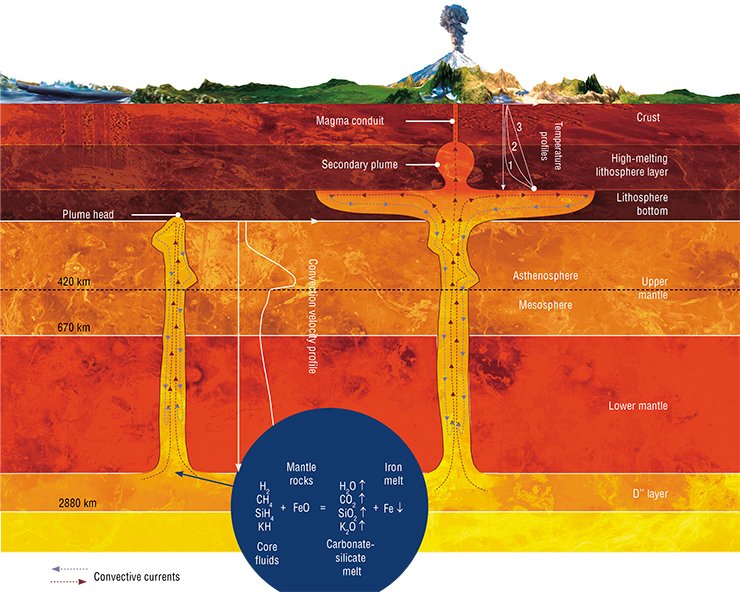
The detailed seismic tomography images of the Hawaii plume show that it forms in the D’’ layer and rises in the mantle nearly vertically (Zhao, 2004). Its structure is in agreement with theoretical predictions.
Helium isotopic composition is a geochemical indicator of the deep origin of plumes. A large proportion of 3He, a product of hydrogen nuclear fusion, is recorded in the rocks of oceanic plumes (e. g., the Hawaii and Iceland plumes). The 3He /4He ratio in these rocks is tens of times higher than in mid-ocean ridge basalts, generating from the upper mantle during thermal convection (Tolstikhin, 2002). Obviously, the excessive 3He is supplied to the plume conduit from the D’’ layer or the outer core.
The plume-mediated matter transfer from the deepest Earth’s bowels is also confirmed by high concentrations of platinum metals(PGE) and osmium isotopic composition. High 186Os / 188Os and 187Os / 188Os ratios recorded in the Hawaii lavas, picrites, and komatiites are interpreted to be generated by the mixing of the matter of the lower mantle and of the outer core (from 1 to 45 %).
The formation of large deposits of PGE*, mainly platinum (Pt) and palladium (Pd) is associated with LIPs. Their high concentrations are recorded in Norilsk basalts and in the Maimecha–Kotui province, which also have major platinum deposits. Komatiite magmatism signs, aged 260 Ma, associated with the Emeishan plume were seen in North Vietnam. Usually, komatiites with specific spinifex texture (named after an Australian grass species) are characteristic of older eras, Archean and Proterozoic. They point to the superheated state of melts at high degrees of mantle melting. Isotopic and geochemical studies of these rocks demonstrate that they are enriched in iridium and osmium (up to 10 ppb) and have unfractionated osmium isotopic compositions, which confirm their lower mantle origin. High contents of Pt and Pd cannot be achieved at high melting degrees and undifferentiated osmium isotopic compositions without the influx of deeper matter.
LIPs: long, long thirty million years
To explain the huge volume of flood basalts (traps) over vast areas, which characterizes LIPs, the thermochemical plume model was developed with regard to the plume break through the cold lithosphere. A plume approaching to the hard-melting base of the lithosphere cannot melt through it and spreads beneath the lithosphere bottom to form a slow secondary plume. It generates fractured sites of alkali basalt eruption. Such a situation can arise not only at the asthenosphere/lithosphere boundary but also at the bottom of the C layer between the lower and upper mantle. This pattern was suggested by S. Maruyama for the Pacific hot field.
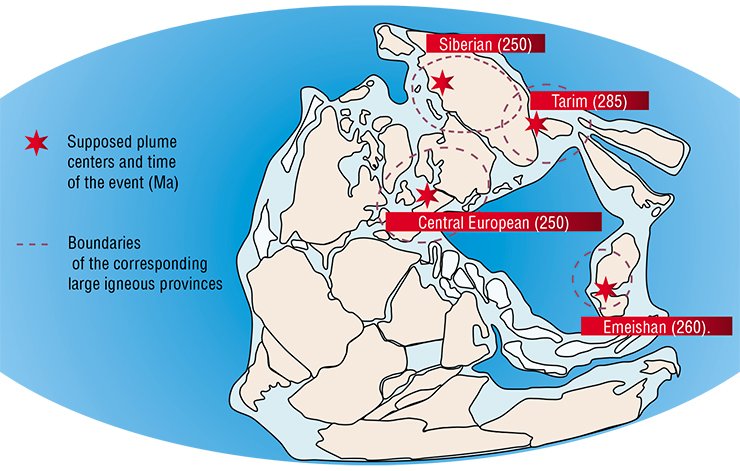
As igneous processes start in the center of a plume, which is the site of the maximum melting degree producing high-magnesium melts. At the margins of the plume, magmatism lags 10—15 Ma behind. These sites are characterized by alkali basalts and felsic (rhyolitic) lavas.
These features are clearly pronounced in the Siberian LIP. The highest-temperature picrite melts, meimechites of the Maimecha–Kotui region, are noted in the center of the Siberian superplume. Their temperature reached 1650 °C in the mantle and 1570 °C at the time of eruption (Sobolev et al., 2009). This temperature is 300 °C higher than that of the convecting upper mantle.
Four stages of the formation of igneous assemblages associated with various types of ore formations are hypothesized on the basis of the theoretical modeling of thermochemical plume evolution and empirical data obtained by now:
- Rise of the Earth’s crust with the approach of the plume to the lithosphere boundary and formation of rift systems characterized by alkali and carbonatite magmatism.
- The main (trap) stage of LIP development: spreading of the plume beneath the lithosphere, accompanied by flood basalt eruption and formation of bimodal igneous bodies (basalt and rhyolite) in marginal areas.
- Crust heating accompanied by intense mantle–crust interaction and formation of gabbro–granitoid complexes and granitoid batholiths.
- The regression stage of plume cooling, characterized by the formation of granitoids with rare metals and belts of dikes of specific (potassium–lamprophyre composition).
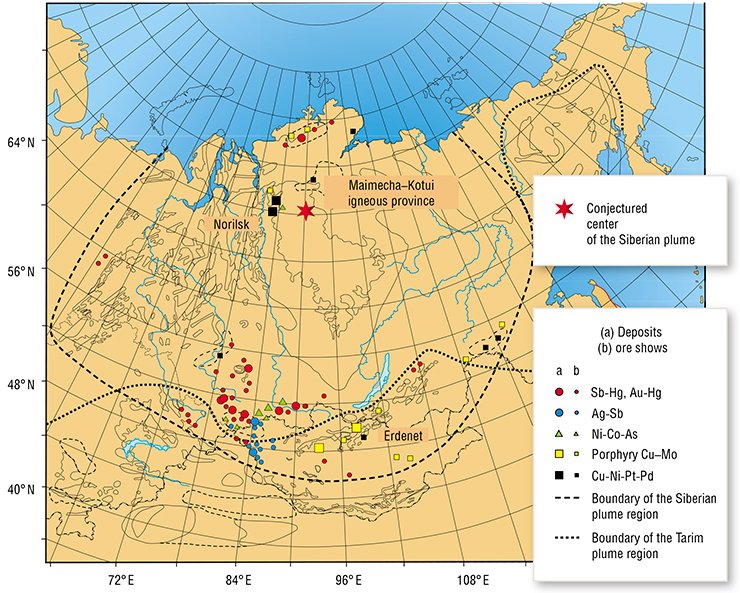
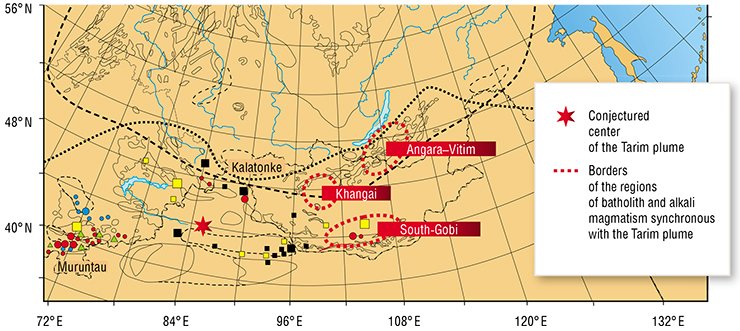
By the example of the LIPs studied, we see that the duration of these stages was 30 Ma, much longer than 1 Ma, as was previously thought. The model also explains the zoning of LIP regions, reflecting the crust–mantle interaction increase towards their margins.
Core metals
Most of deposits of noble, nonferrous, and rare metals form in two settings: subduction zones and LIPs associated with mantle plumes. Exceptions are black smokers in mid-ocean ridges, where lead and zinc are deposited. However, giant deposits like Bushveld, Norilsk, and Muruntau are closely associated with LIPs, and their location and ages show certain regularities.
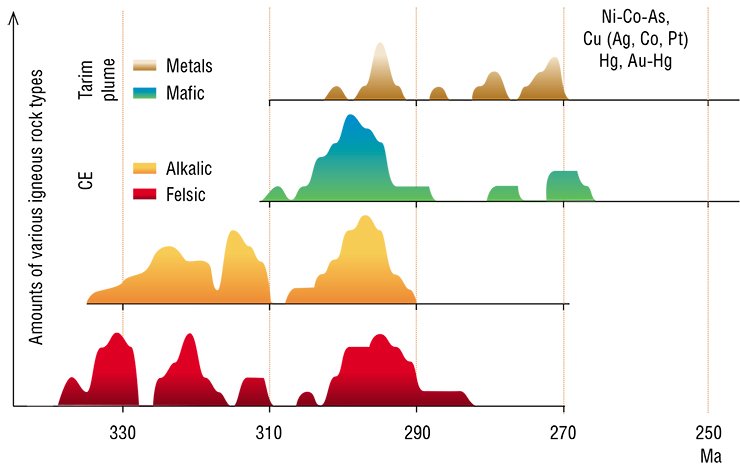
A large endogenous mineralization assemblage appears within the LIPs associated with the Siberian and Tarim plumes. The emergence of ore magmatic complexes and metal deposits, from cobalt and nickel to gold and mercury, was synchronous with plume magmatism (Pirajno, 2004; Borisenko et al., 2006; Dobretsov et al., 2010).
The separation of mantle and core magmatism and the associated mineralization is in agreement with the stages conjectured on the basis of the model of interaction between a thermochemical plume and the lithosphere. By analyzing spatiotemporal associations between magmatism and mineralization, we have constructed an idealized model of mineralization succession and location in LIPs.
Plume magmatism shows the closest spatiotemporal and genetic linkage with copper–nickel–platinum mineralization. An example is the unique Norilsk deposits of copper, nickel, and PGE, which make Russia second in the world in their reserves and production. Their formation corresponds to the trap stage of LIP development. The same pattern of the location of large and unique ore deposits is observed in other igneous provinces of the world: Muskox in Canada, Skaergaard (Au and Pd) in Greenland, etc. Low-temperature hydrothermal Ni–Co–Ag–As deposits and Cu sandstones are associated with trap magmatism in less eroded regions.
Gold-arsenic deposits in LIP margins may be associated with the main stage of LIP development. Such is the location of the Early Permian large and giant gold deposits of Tian Shan, East Kazakhstan, and Chinese Altai, belonging to the Tarim LIP. However, such marginal deposits more often form at the next stage, during the intense interaction between the crust and the mantle.
The last LIP development stage is characterized by magmatism diverse in composition. It includes regions of alkali and mafic dike rock assemblages, intrusions of gabbro–granite composition, and rare-metal granites. They are associated with the corresponding types of low-temperature hydrothermal mineralization: Sb–Hg, Mo–W, etc.
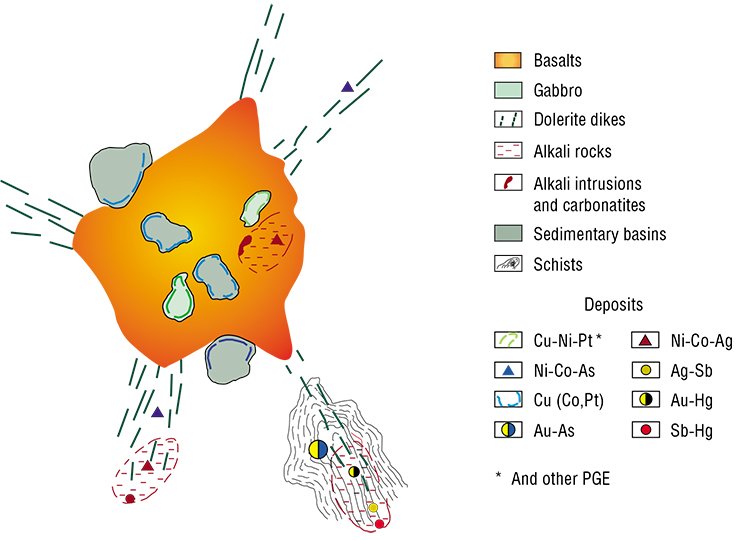
Such staging of igneous processes and ore formation is observed in other LIPs of the Earth, varying in age. The results show that the entire specific pattern of igneous and hydrothermal mineralization is a characteristic feature of metal ore formation in LIPs. This indicates that specific mineralization types may be metallogenic indicators of mantle plumes.
Thus, analysis of magmatism and ore formation in the Siberian, Tarim, Emeishan, and Central European LIPs shows that the thermochemical model of deep mantle plumes adequately explains not only the mantle magmatism features but also the specific pattern of ore formation. The detected features of the distribution of various mineralization types in LIP regions, temporal and genetic linkage between mineralization and certain magmatism types, and specificity of the geologic settings of mineralization provide grounds for developing a set of criteria for the prediction and evaluation of the potential of new commercial deposits.
Тhe thermochemical model of deep mantle plumes adequately explains not only mantle magmatism features but also the specific pattern of ore formation. The regularities in the location of mineralization types revealed in large igneous provinces and the temporal and genetic linkage between mineralization and certain magmatism types can provide grounds for developing a set of criteria for the prediction and evaluation of the potential of new commercial deposits. The examples presented in this paper have something in common with the paper by Kuzmin and Yarmolyuk published in this issue of the journal as they provide another illustration of the activity of the Earth’s mantle and the core–mantle boundary.
References
Borisenko A. S. i dr. Permotriasovoe orudenenie Azii i ego svjaz’ s projavleniem pljumovogo magmatizma // Geol. i geofiz. 2006. T. 47, № 1. S. 166—182.
Dobrecov N. L. Osnovy tektoniki i geodinamiki: Uchebnoe posobie. Novosibirsk: Izd-vo NGU, 2011.
Dobrecov N. L., Kirdjashkin A. G., Kirdjashkin A. A. ¬Glubinnaja geodinamika. Novosibirsk: Izd-vo SO RAN; filial «Geo», 2001. 409 s.
Sobolev A. V. i dr. Mehanizm obrazovanija sibirskih mejmechitov i priroda ih svjazi s trappami i kimberlitami // Geologija i geofizika. 2009. t. 50, № 12. S. 1293—1335.
Hain V. E. Osnovnye problemy sovremennoj geologii. 2003.
Coffin M. F., Eldholm O. Large Igneous Provinces: Crustal Structure, Dimensions, and External Consequences // Rev. Geophys. 1994. Vol. 32, No. 1. P. 1—36.
Pirajno F. Ore deposits and mantle plumes. Dordrecht: Kluwer Academic Publishers, 2004.
Zhao D. Global tomographic images of mantle plumes and subducting slabs: insight into deep earth dynamics // Physics of the Earth and Planetary Interiors. 2004. Vol. 146. P. 3—34.
* PGE – platinum group elements : Ru, Rh, Pd, Os, Ir, Pt












